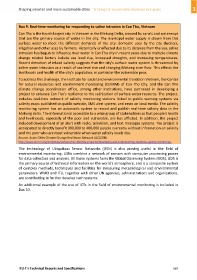Page 577 - Shaping smarter and more sustainable cities - Striving for sustainable development goals
P. 577
Box 9. Real‐time monitoring for responding to saline intrusion in Can Tho, Vietnam
Can Tho is the fourth largest city in Vietnam in the Mekong Delta, crossed by canals and waterways
that are the primary source of water in the city. The municipal water supply is drawn from this
surface water to meet the different demands of the city: domestic uses by the city dwellers,
irrigation and other uses by farmers. Historically unaffected due to its distance from the sea, saline
intrusion has begun to influence river water in Can Tho city in recent years due to multiple climate
change related factors include sea level rise, increased droughts, and increasing temperatures.
Recent detection of inland salinity suggests that the city's surface water system is threatened by
saline water intrusion as a result of sea level rise and changing Mekong river flow. This affects the
livelihoods and health of the city's population, in particular the vulnerable poor.
To address this challenge, the Institute for social and environmental transition Vietnam, the Center
for natural resources and environment monitoring (CENRM) of Can Tho City, and the Can Tho
climate change coordination office, among other institutions, have partnered in developing a
project to enhance Can Tho's resilience to the salinization of surface water resource. The project,
includes real‐time network of salinity monitoring stations linked to public warning systems via
salinity maps published on public website, SMS alert system, and news on local media. The salinity
monitoring system has an automatic system to record and publish real‐time salinity data in the
Mekong delta. The information is accessible to a wide group of stakeholders so that people's health
and livelihoods, especially of the poor and vulnerable, are less afflicted. In addition, the project
included development of an alert with radio, television, and text messages systems. The project is
anticipated to directly benefit 300,000 to 400,000 people currently without information on salinity
and the poor who are most vulnerable when water salinity levels rise.
Source: Asian Cities Climate Change Resilience Network (ACCCRN)
http://www.acccrn.org/initiatives/vietnam/can‐tho/city‐projects/developing‐and‐implementing‐real‐time‐salinity‐monitoring‐
The technology of Ubiquitous Sensor Networks (USN) is also proving useful in the field of
environmental monitoring. USNs combine a network of sensors with computer processing power
for data collection and analysis. All these systems form the Global Observing System (GOS). GOS is
the primary source of technical information on the world's atmosphere, and is a composite system
of complex methods, techniques and facilities for measuring meteorological and environmental
parameters. WMO and ITU, together with other UN agencies, administrations and organizations,
are contributing to further develop such systems.
An additional example of the use of ICTs in the field of environmental monitoring is included in
Box 10.
ITU‐T's Technical Reports and Specifications 567

